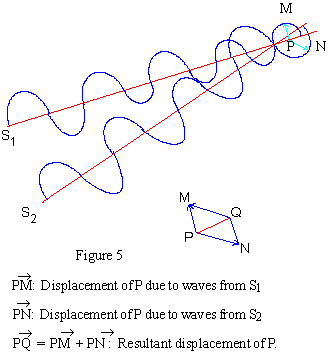|
10.3 Superposition Principle
The effect of two or more waves, on the oscillations
of particles of a medium at which the waves arrive simultaneously,
is given by the superposition principle.
It states that "The resultant vibration of
any particle at which two or more waves arrive simultaneously is
given by the Vector addition of displacements given to the particle
of each wave independently of the other."
The principle is illustrated in the following diagram:

Note
-
The use of transverse waves is just for visual
effect.
-
If the angle subtended at P by the lines of
propagations S1P and S2P of the waves
is negligible, i.e. the distance between sources S1S2
is much smaller than the distance of either of the sources from
'P',then PM and PN are either parallel to each other or are
anti - Parallel to each other.
-
When  and in same direction as PM or PN. This condition is called
constructive interference.
and in same direction as PM or PN. This condition is called
constructive interference.
-
When PM anti- || to PN then PQ = PM - PN or
PQ = PN- PM which ever is +ve and in the direction of the greater
of the two.
|
Index
10.1 Intensity and Pitch
10.2 Doppler Effect
10.3 Superposition Principle
10.4 The Phenomenon of Beats of Sound
10.5 Standing or Stationary Waves
10.6 Forced Oscillations and Resonance
Chapter 11
|


